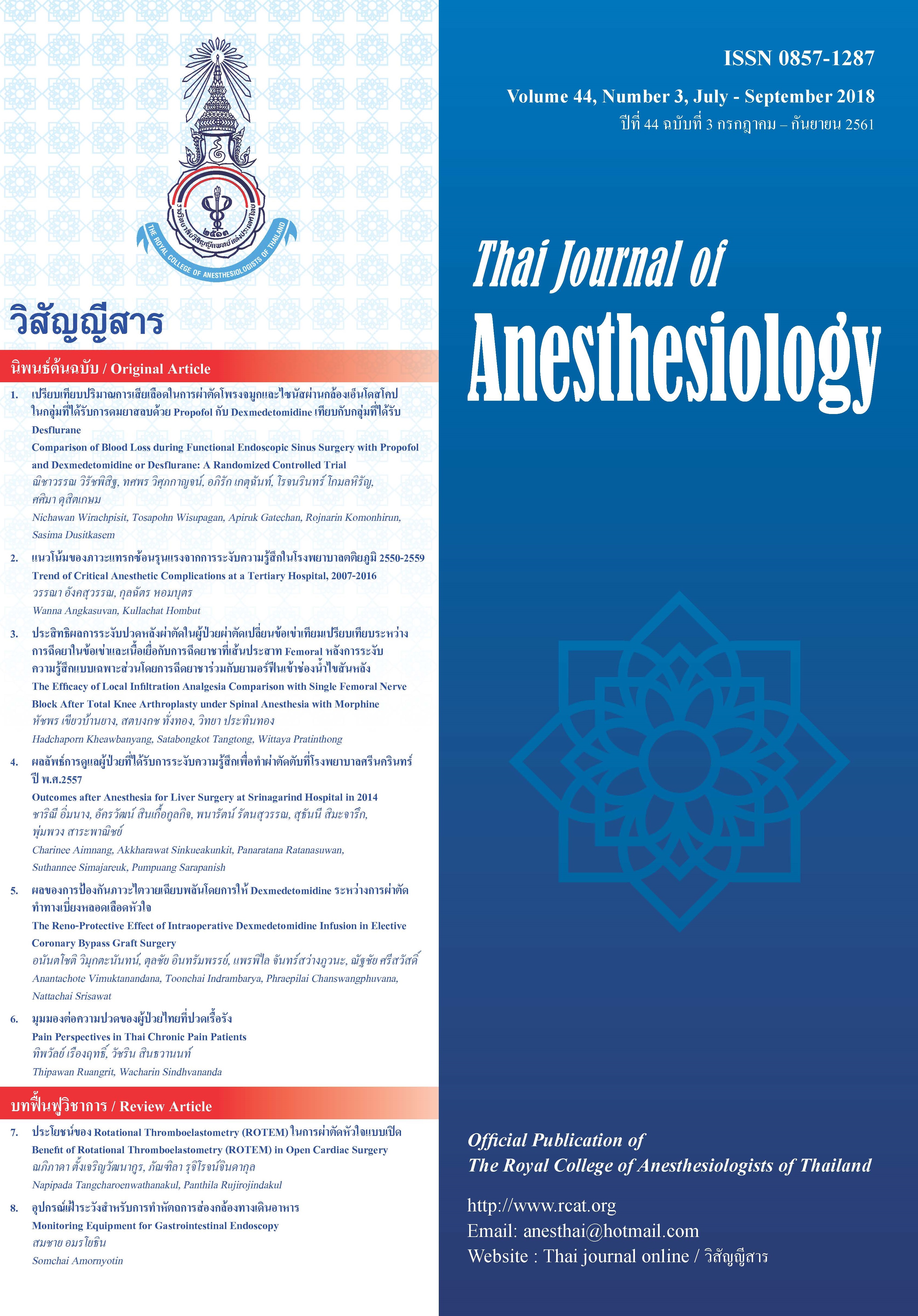Outcomes after Anesthesia for Liver Surgery at Srinagarind Hospital in 2014
Main Article Content
Abstract
Background: Liver surgery is a complex and high-risk surgery. It requires an experienced anesthesia team with update and specific knowledge during anesthesia and surgery to meet the best patients’ outcomes.
Objectives: To study the outcomes of patients underwent liver surgery at Srinagarind Hospital, Khon Kaen University, Khon Kaen, Thailand in 2014 as a means to improve the quality of patients’ anesthetic care.
Methods: A retrospective descriptive study in all patients with liver surgery at Srinagarind Hospital between January 1, 2014 and December 31, 2014.
Results: A total of 140 patients, 73.57% received general anesthesia combined with epidural anesthesia during surgery. The study showed the average amount of blood loss was 495.10 ± 428.10 ml, core temperature was 35.39 ± 0.61 oC, CVP was 9.2 ± 2.8 mmHg, systolic blood pressure was 103.83 ± 12.30 mmHg and urine output was 1.03 ± 0.89 ml/kg/hr. After surgery, 73.57% of patients received epidural analgesia for postoperative pain relief.
Conclusions: Patients underwent liver surgery received the appropriate standard of care. Excluding CVP control during surgery was higher than the recommendation (recommendation: not exceed than 5 mmHg). Also the average core temperature during surgery was lower than the standard (standard: not below 36 oC).
Article Details
References
2. Neto LJ, Thomson JC, Cardoso JR. Postoperative respiratory complications from elective and urgency/ emergency surgery performed at a university hospital. J Bras Pneumol 2005;31:41-7.
3. Lawrence VA, Hilsenbeck SG, Mulrow CD, et al. Incidence and hospital stay for cardiac and pulmonary complications after abdominal surgery. J Gen Intern Med 1995;10:671-8.
4. Smetana GW. Postoperative pulmonary complications: An update on risk assessment and reduction. Cleve Clin J Med 2009;76:s60-5.
International anesthesia research society. Liver surgery (guide) hepatectomy. 2004: [Internet]. Available at: http:// www.openanesthesia.org/Liver_Surgery. (Access on 2 Feb 2015).
6. Melendez JA, Arslan V, Fischer ME, et al. Perioperative outcomes of major hepatic resection under low central venous pressure anesthesia, blood loss, blood transfusion, and risk of postoperative renal dysfunction. J Am Coll Surg 1998;187:620-5.
7. Wang WD, Liang LJ, Yin XY. Low central venous pressure reduces blood loss in hepatectomy. World J Gastroenterol 2006;120:935-9.
8. Hughes MJ, Ventham NT, Harrison EM, Wigmore SJ. Central venous pressure and liver resection: a systematic review and meta-analysis. HPB (Oxford) 2015;17:863-71.
9. Li Z, Sun YM, Wu FX, Yang LQ, Lu ZJ, Yu WF. Controlled low central venous pressure reduces blood loss and transfusion requirements in hepatectomy. World J Gastroenterol 2014;20:303-9.
10. Chen H, Merchant NB, Didolkar MS. Hepatic resection using intermittent vascular inflow occlusion and low central venous pressure anesthesia improves morbidity and mortality. Journal of Gastrointestinal Surgery 2000;4:162-7.
11. Simajareuk S, Ratanasuwan Yimyaem P, Sorasit C, Kaijanad C, Suwanatri K. Analgesic efficacy of postoperative pain management following upper abdominal surgery in Srinagarind Hospital . Srinagarind Med J 2014;29:269-75.
12. Kainzwaldner V, Rachinger-Adam B, Mioc-Curic T, et al. Quality of postoperative pain therapy. Evaluation of an established anesthesiology acute pain service. Anaesthesist 2013;62:453-9. (English abstract).
13. Michael Holtz. 2016. Normal urine output [Internet]. Available at: https://wikem.org/wiki/Normal _urine_output. (Access on 2 Feb 2015).
14. Sessler DI. Temperature regulation and monitoring. In: Miller RD, editor. Anesthesia 7th ed. Philadelphia: Churchill Livingstone, 2014: p 1622-44.


